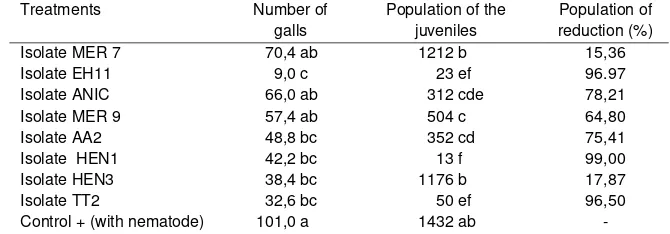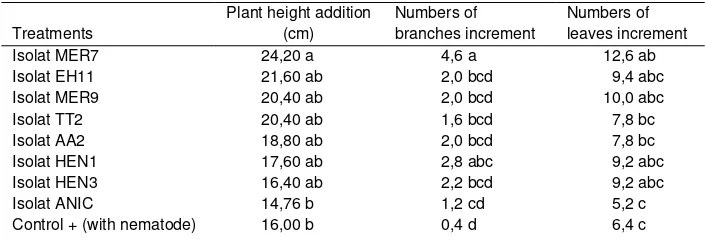Proceedings of The 7th ACSA Conference 2011 315
Endophytic Bacteria as an Alternative Agent for the Biological Control
of Plant Parasitic Nematodes on Black Pepper
Abdul Munif
a,*, Rita Harni, Siswanto
ba
Department of Plant Protection, Bogor Agricultural University ,Bogor, Indonesia b
Research and Development Agency, Ministry of Agriculture, Indonesia *Corresponding author: Department of Plant Protection, Bogor Agricultural University,
Jl. Kamper Kampus IPB Darmaga, Bogor, Indonesia 16680. [email protected]
Abstract
Plant parasitic nematodes cause damage and losses significantly to black pepper in Indonesia. Control of plant parasitic nematodes with pesticides is often restricted due to their high toxicity and negative impact on the environment. The need for environmentally safe control strategies has increased interest in developing biological control measures.Endophytic bacteria are ubiquitous in most plant species and reside within healthy plant tissue without producing symptoms of damage. The internal plant habitat provides several advantages for endophytic bacteria as biological control agents: 1) colonization of an ecological niche also used by plant pathogens, 2) less competition with other microorganisms, 3) sufficient supply wirth nutrients, 4) less exposure to environmental stress factors, and 5) better translocation of bacterial metabolites throughout the host plant. The objective of this work was to evaluate the effect of endophytic bacteria isolated from black pepper to control Meloidogyne incognita on black pepper. The results showed that some endophytic bacteria were able to reduce the root galls caused by Meloidogyne incognita and juveniles of nematodes in the soil up to 70% as well as to promote the growth of pepper seedlings.
Keywords: endophytic bacteria, Meloidogyne incognita, black pepper, root gall
Introduction
Black pepper (piper nigrum L) is one of the important export commodities in Indonesia. However, the production of black pepper is now threatened by pests and diseases. One of the main disease on black peper is yellow diseasae caused by plant parasitic nematodes i.e. Meloidogyne
sp. and Radopholus similis. Several control methods have been developed to combat the nematodes, but they are still a serious problem of black pepper especially in Bangka Island, Indonesia. The use of chemical pesticides with persistent pesticides can result in negative impacts to the environment, pathogens become more resistant, disruptive presence of beneficial microbes in the soil, and human health. Use of pesticides also provides residual effects on pepper which is currently an one obstacle for consumers, mainly for export purposes that are very concerned about the health and environmental aspects. In connection with the need to develop a system of agricultural production, including plant disease control systems are environmentally sound one of them by optimizing the use of biological agents.
316 Proceedings of The 7th ACSA Conference 2011 it can increase the availability of nutrients to induce plant resistance. The objective of this research
was to determine the potential of biological agents bacterial endophytes isolated from pepper for controlling Meloidogyneincognita on pepper and their effects on the plant growth.
Materials and Methods
Isolation of Endophytic Bacteria
A total of 10 samples of healthy pepper plants were taken at random each of pepper plants and were cultivated in Bangka, Bogor and Sukabumi. The pepper plant roots were transported to the laboratory for immediate processing. The roots were washed with running tap water to remove adherent soil particles then blotted dry on tissue paper. The root material was weighed and surface sterilized with alcohol at 70% for 30 sec and in 2% of sodium hypochlorite (NaOCl) containing 0.01% of Tween 20 for 3 min, followed by four rinses with sterile 0.01 M of potassium phosphate buffer (PB) at pH of 7.0 (80 g NaCl, 2 g KCl, 11.5 g Na2HPO4, 2 g KH2PO4). To confirm complete surface sterilization (sterility check), the surface disinfected roots were imprinted on Tryptic Soy Agar (TSA). If bacterial growth occurred within 48 h, samples were discarded. The pepper roots were then macerated with a sterile mortar and pistil in three times PB (w/v). The macerate was decanted into sterile conical flasks and shaken for 30 sec. A dilution series was made and 100 µl of each dilution was plated onto 1/10 strength of TSA on petri disk. Petri plates were incubated at 24°C for 2-3 days and colony forming units (cfu) were determined. Three replicates were made for each dilution. On each petri plate containing approximately 10 bacterial strains was marked and all bacterial strains from this zone were transferred and purified on full strength of TSA. The bacterial strains were stored in Tryptic Soy Broth (TSB) plus 20% of glycerol at -20°C. Two isolates collection of endophytic bacteria were used in this experiment.
Inoculum of Parasitic Nematodes
Inoculum of nematode Meloidogyne incognita was isolated from the infected roots pepper of nematodes in Central Bangka, Province Bangka-Belitung Indonesia. Subsequently, the nematodes were cultured and propagated on susceptible tomato plants (cv. Ratna) for 2 months. After that plant was uprooted and the nematodes was extracted and used as a source of inoculum.
Effect of Endophytic Bacteria on Meloidogyne incognita
Proceedings of The 7th ACSA Conference 2011 317 Results and Discussion
Effect of Endophytic Bacteria against M. incognita on Black Pepper
In this study, eight isolates of endophytic bacteria isolated from root pepper and patchouli were tested on seedling of black pepper against M. incognita in the greenhouse. All of isolates of bacterial endophyte were able to reduce gall and juveniles of M. incognita. Four out of eight isolates, i.e EH11, HEN1, HEN3 and TT2 significantly reduced gall nematodes compared to the control. Isolate EH11 showed the highest in reducing gall nematodes compared to other isolates (Table1). The isolates of bacteria were also able to suppress juveniles of nematode in the soil compared to control. Six isolates of EH11, AA2, HEN1, MER9, ANIC and TT2 significantly reduced number of juveniles compared to control. The highest influence in suppressing number of juveniles of M.incognita was showed by isolate HEN1 and followed by EH11. Five Isolates of HEN1, EH11, TT2, ANIC, and AA2 were able to reduce the population of M. incognita in the soil at more than 75%.
Table 1. Effect of isolates of biological agents bacterial endophyte against the number of galls and the population of nematodes larvae
Treatments Number of
galls
Population of the juveniles
Population of reduction (%)
Isolate MER 7 70,4 ab 1212 b 15,36
Isolate EH11 9,0 c 23 ef 96.97
Isolate ANIC 66,0 ab 312 cde 78,21
Isolate MER 9 57,4 ab 504 c 64,80
Isolate AA2 48,8 bc 352 cd 75,41
Isolate HEN1 42,2 bc 13 f 99,00
Isolate HEN3 38,4 bc 1176 b 17,87
Isolate TT2 32,6 bc 50 ef 96,50
Control + (with nematode) 101,0 a 1432 ab -
Values followed by same small letters on the same column are not significantly different at 5% by DMRT.
Biological agents can suppress the development of plant diseases through a mechanism of competition, predation and the resulting antibiotics (Kloepper et al. 1991). Some research indicates that the use of biological agents endophytic bacteria through seed treatment reduce 30-50% of the amount of gall of M. incognita on cotton plants (Hallmann et al. 1997). Some bacterial endophytes isolated from the roots patchouli suppress populations of Pratylenchus brachyurus at 73.9% on patchouli plants in the greenhouse (Harni et al. 2007). Biological agents, including endophytic microbial may protect plants against plant-parasitic nematodes through various ways such as by producing toxic compounds that are nematicidals (Sikora et al. 2007; Yang et al. 2011). In addition, certain bacteria can also suppress the development of plant diseases due to the ability of bacterial endophytes in binding Fe (III) and to produce HCN (Keel et al. 1992). A treatment of culture filtrate of endophytic bacterial isolate isolated from patchouli was also able to reduce
Pratylenchus barchyurus larvae up to 100%, 24 h after the treatment (Harni 2007).
318 Proceedings of The 7th ACSA Conference 2011
Table 2. The influence of endophytic bacteria on the growth of pepper plants inoculated with M. incognita 3 months after treatment
Treatments
Plant height addition (cm)
Numbers of branches increment
Numbers of leaves increment
Isolat MER7 24,20 a 4,6 a 12,6 ab
Isolat EH11 21,60 ab 2,0 bcd 9,4 abc
Isolat MER9 20,40 ab 2,0 bcd 10,0 abc
Isolat TT2 20,40 ab 1,6 bcd 7,8 bc
Isolat AA2 18,80 ab 2,0 bcd 7,8 bc
Isolat HEN1 17,60 ab 2,8 abc 9,2 abc
Isolat HEN3 16,40 ab 2,2 bcd 9,2 abc
Isolat ANIC 14,76 b 1,2 cd 5,2 c
Control + (with nematode) 16,00 b 0,4 d 6,4 c
Values followed by same small letters on the same column are not significantly different at 5% Duncan test.
Inoculation with nematodes caused damage from the stabbing stylet and secretion of enzymes released nematodes when the nematodes feed. Hallmann et al. (1997) reported that nematodes are taking root cells can reduce the ability of plants to absorb water and nutrients from the soil and cause symptoms such as lack of water and nutrients. Besides, the reduced concentration of plant growth regulators such as auxins, cytokinins and gibberellins can occur because the nematode secretes enzymes cellulose and pectinase that may degrade the cell up to the root tip injuries and broken, this leads to auxin is not active then growth of plant will be stunted.
Acknowledgements
The authors would like to thank the leader of the program at the Secretariat of Research and Development. The research was made possible with the support of funding from the State Budget of Research and Development Agency, Ministry of Agriculture.
References
Hallmann J, Quadt-Hallmann A, Mahaffee WF, Kloepper JW. 1997. Bacterial endophytes in agricultural crops. Canadian Journal of Microbiology 43:895-914
Hallmann J, Quadt-Hallmann A, Miller WG, Sikora RA, Lindow SE. 2001. Endophytic colonization of plant by biocontrol agent Rhizobium etli G12 in relation to Meloidogyne incognita infection. Pyhtopathology 91:415-422
Harni R, Munif A, Supramana, Mustika I. 2007. Pemanfaatan bakteri endofit untuk mengendalikan nematode peluka akar (Pratylenchus brachyurus) pada tanaman nilam. Jurnal Hayati 14 (1): 7-12.
Keel C, Schneider U, Maurhofer M, Voisard C, Laville J, Burger U, Withner P, Hass D, Defago G. 1992. Suppression of root disease by Pseudomonas fluorescens CHAO: Importance of the bacterial secondary metabolite 2,4 diacetylphloroglucinol. Mol. Plant-Microbe Interaction 5:4-13.
Kloepper JW, Zablotowiz RM, Tipping EM, Lifshiftz R. 1991. Plant growth promoting mediated by bacterial rhizosphere colonizers. In: Keister DL and Cregan PB.(Eds.). The Rhizosphere and Plant Growth. Kluwer Academic Publisher. Dordrecht, The Netherland. P:315-326.
Sikora RA, Schafer K, and Dababat AA. 2007. Modes of action associated with microbially induced in planta suppression of plant parasitic nematodes. Australasian Plant Pathol. 36:124-134.
Vetrivelkalai P, Sivakumar M, Jonathan FI. 2010. Biocontrol potential of endophytic bacteria on Meloidogyne incognita and its effect on plant growth in bhendi. Journal of Biopesticides 3 (2): 452-457
Yang CJ, Zhang XG, Shi GY, Zhao HY, Chen L, Tao K, Hou TP. 2011. Isolation and Identification of endophytic bacterium W4 against tomato Botrytis cinerea and antagonistic activity stability. African Journal of Microbiol. Res. 5 (2): 131-136.

